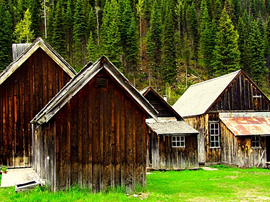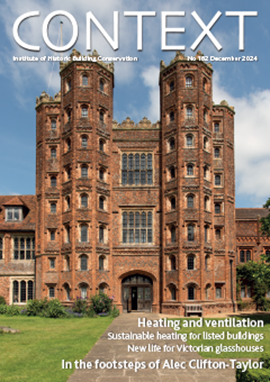Solar panels and listed structures
With the climate crisis creating a desperate need to adopt renewable energy technologies, it should be made easier to install solar panels on or in the vicinity of listed structures.

|
| Rooftop solar panels at Grade II* listed Tissington Hall in Derbyshire. |
A country house owner in the middle of the Derbyshire Peak District sought to take advantage of his property’s flat roof by installing a small rooftop solar array. The panels would be relatively modest in size and anyway would be hidden from sight by the turrets that decorate the top of the building. What objections could there possibly be to such a green initiative?
Many months later, and after much to-ing and fro-ing between the owner and the planning authority, the solar installation was finally permitted. By then, the cost of the work had increased by thousands of pounds because of the delays caused when the planning authority initially declined to give its support to the proposal. Among other things, the owner had been forced to create photomontages to show how the solar panels would not impinge on the beauty of the view for walkers as they descended a nearby footpath.
Solar panels on roofs can be controversial, as the recent case of King’s College Chapel in Cambridge has shown all too publicly (see John Preston’s ‘A world-wide precedent for solar panels?’, Context 176, June 2023). It should be easier, not harder, to install such things on or in the vicinity of listed structures.
There is huge enthusiasm among the owners and custodians of larger country houses for making their buildings more energy efficient. Athelhampton House in Dorset has become one of the first net-zero country houses, after installing heat pumps and solar panels. Ten air-source pumps help to feed the house with a steady supply of warmth. A bank of Tesla batteries stores any surplus power generated from the solar array in the walled garden. This power can be sold back into the national grid to make a return for the property.
Country houses have the potential in this way to become a distributed network of power stations, generating heat and power for local use. Walled gardens are perfect locations for solar arrays. The sun beating down on rooftops could be harvested and converted into warmth or electricity. Lake-source heat pumps could help to generate all-year-round heating. However, at present much of this potential is being squandered.
Eighty-seven per cent of member properties at Historic Houses, combined with the historic property owners represented by the CLA (Country Land and Business Association), say that they have been held back from investing in their properties in this way by a planning system that is far too complex and restrictive. Athelhampton benefited from having advice from officials at Historic England, who were keen to find ways in which the energy installations could be integrated relatively unobtrusively into the Grade I medieval fabric of the building. Owners of Grade II* or Grade II buildings (in England) do not always find that their local planning office is quite as accommodating. More often, the response will be a straightforward refusal. (Historic England has commissioned new research into exactly how frequent such refusals are; as yet the research remains unpublished.)
One reason for making the case for renewable energy installations in listed buildings is that such changes are, ultimately, often reversible. The 1990 act makes no distinction in law regarding whether a proposed change to a listed building is reversible or not (though this may of course form part of the consideration of the proposed change). One day, as a result of future technological changes, it may no longer be necessary for air-source heat pump units to be quietly humming at the backs of listed properties. But for the time being, why should the planning system put barriers in the way of owners wishing to install such devices?
In 2013 the government gave itself the authority to introduce shortcuts to the listed building consent process for certain prescribed works. The Enterprise and Regulatory Reform Act enabled planning authorities, whether nationally or locally, to introduce listed building consent orders (LBCOs) to enable works on listed structures to proceed without the prior authorisation attained after a listed building consent application.
Despite changing the law in this way, the current government has been surprisingly reluctant to make use of these powers. In the 10 years since the law was changed, precisely zero LBCOs have been introduced at a national level. A handful of local authorities have made use of the powers to introduce local-level LBCOs, as has been seen in the Royal Borough of Kensington and Chelsea (RBKC) in London. Here, two local LBCOs have made it possible for owners of Grade II buildings to install solar panels on roofs (provided certain conditions are met), and for certain works on windows to proceed in the interests of energy efficiency.
It is unclear why a government so committed to ‘levelling up’ appears willing to see the residents of an affluent London borough enjoy freedoms that are denied to people living in other parts of the country, especially in rural areas. It is also unclear whether any of the dire warnings voiced by those heritage organisations that objected to the introduction of the RBKC consent orders (and several did) have yet come to pass.
A blanket consent for, say, Grade II buildings anywhere in the country to be allowed to carry solar panels could be accompanied by detailed specifications as to the conditions that owners would need to meet. Some roofing types are clearly inappropriate for carrying solar panels. Just as in the RBKC, it could be specified that such rooftop installations should be invisible from public highways.
The introduction of an LBCO for solar in this way would cost the government nothing. It would signal a huge reduction in administrative time and effort, and it could be the spur that would encourage significant investment by owners in carbon-friendly building technologies. It would also reduce the level of casework faced by local authority conservation officers, freeing up more time and resource for the more serious casework.
The LBCO route could be used to improve the process for making other small changes to rural listed properties of all sizes. A general approval could be given to allow owners to introduce secondary glazing in their properties, for example. It remains uncertain at present whether full listed building consent is required at all for secondary glazing. An LBCO could end the uncertainty.
Using consent orders in this way would not mean that every single listed building (or listed place of worship) would automatically acquire a solar array on its roof, or secondary glazing behind its front windows. Such investments remain at the discretion of the owners of these properties. These owners usually only want to invest in such changes to improve their buildings. They are unlikely to deliberately trash the heritage in their care. On the contrary, they will be making it more liveable and therefore more sustainable. Backstop powers could surely be contrived to force owners to reverse any especially egregious installation schemes.
The government promised in its Energy Security Strategy to review the regulations that impinge on the energy efficiency of listed buildings. At the time of writing, the publication of the review is already almost a year overdue. This is a real shame, at a time when the installation of energy efficiency measures enjoys (until 2027) zero-rated VAT.
There is a desperate need to adopt renewable energy technologies. Listed buildings such as larger country houses are able to carry solar panels and heat pumps with relatively little impact on their appearance or their significance. Any such impact is reversible, since the solar panels and heat pump units could be taken away at some point in the future. Perhaps Context readers will find all sorts of perfectly rational objections to this proposal. But these need to be weighed against the pressing need to find solutions to the climate crisis.
This article originally appeared as ‘Power houses’ in the Institute of Historic Building Conservation’s (IHBC’s) Context 178, published in December 2023. It was written by Ben Cowell, director general of Historic Houses..
--Institute of Historic Building Conservation
Related articles on Designing Buildings
- 100 Sustainable Scottish Buildings.
- Conservation.
- Heritage.
- Historic environment.
- IHBC articles.
- Institute of Historic Building Conservation.
- Planning decision to allow photovoltaic panels on the roof of King's College Chapel.
- Planning for sustainable historic places.
- Reconciling conservation and sustainable development.
- Sustainability and Conservation of the Historic Built Environment - an IHBC Position Statement.
- World Heritage and Sustainable Development: new directions in world heritage development.
IHBC NewsBlog
SAVE celebrates 50 years of campaigning 1975-2025
SAVE Britain’s Heritage has announced events across the country to celebrate bringing new life to remarkable buildings.
IHBC Annual School 2025 - Shrewsbury 12-14 June
Themed Heritage in Context – Value: Plan: Change, join in-person or online.
200th Anniversary Celebration of the Modern Railway Planned
The Stockton & Darlington Railway opened on September 27, 1825.
Competence Framework Launched for Sustainability in the Built Environment
The Construction Industry Council (CIC) and the Edge have jointly published the framework.
Historic England Launches Wellbeing Strategy for Heritage
Whether through visiting, volunteering, learning or creative practice, engaging with heritage can strengthen confidence, resilience, hope and social connections.
National Trust for Canada’s Review of 2024
Great Saves & Worst Losses Highlighted
IHBC's SelfStarter Website Undergoes Refresh
New updates and resources for emerging conservation professionals.
‘Behind the Scenes’ podcast on St. Pauls Cathedral Published
Experience the inside track on one of the world’s best known places of worship and visitor attractions.
National Audit Office (NAO) says Government building maintenance backlog is at least £49 billion
The public spending watchdog will need to consider the best way to manage its assets to bring property condition to a satisfactory level.
IHBC Publishes C182 focused on Heating and Ventilation
The latest issue of Context explores sustainable heating for listed buildings and more.
















